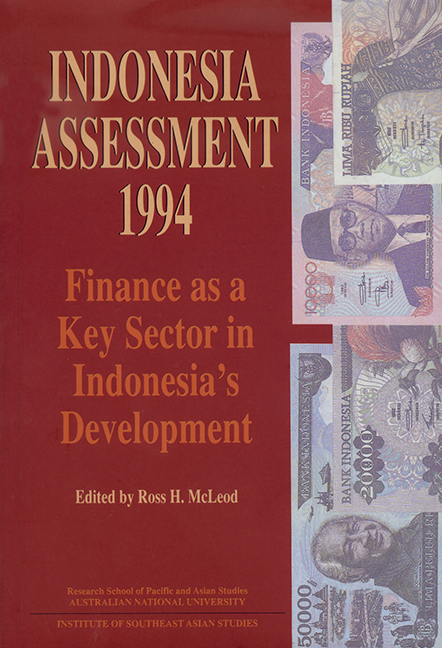Book contents
- Frontmatter
- Contents
- Tables, figures, appendices
- Foreword
- Glossary
- Contributors
- Acknowledgements
- 1 Introduction
- PART A ECONOMIC AND POLITICAL DEVELOPMENTS
- 2 Recent economic developments
- 3 Organising the transition: Indonesian politics in 1993/94
- PART B FINANCE AS A KEY SECTOR IN INDONESIA'S DEVELOPMENT
- References
- Index
2 - Recent economic developments
from PART A - ECONOMIC AND POLITICAL DEVELOPMENTS
Published online by Cambridge University Press: 21 October 2015
- Frontmatter
- Contents
- Tables, figures, appendices
- Foreword
- Glossary
- Contributors
- Acknowledgements
- 1 Introduction
- PART A ECONOMIC AND POLITICAL DEVELOPMENTS
- 2 Recent economic developments
- 3 Organising the transition: Indonesian politics in 1993/94
- PART B FINANCE AS A KEY SECTOR IN INDONESIA'S DEVELOPMENT
- References
- Index
Summary
The Indonesian economy continued to perform very well in 1994. Growth of output was brisk, and inflation was reasonably well under control. The balance of payments has been generally strong; fears of a sustained fall in oil prices proved unfounded, although the disappointing growth performance of non-oil exports in 1993 (especially in textiles and garments) seems not yet to have been corrected. Management of the money supply has been reasonably successful (although money growth will probably need to be cut back if inflation is to be lowered), but it has been made difficult by large and fluctuating levels of capital flows to and from overseas—which call into question the appropriateness of current exchange rate policy.
Introduction of a new five-year development plan and the second long-term (25 year) development plan have been highlights of economic policy-making in 1994, together with the introduction of new policy packages concerning foreign investment, trade, and small business finance. Of these, the foreign investment package seems by far the most significant. The trade package was regarded by many as a disappointment—especially by industries which are reliant on importable inputs—demonstrating the continuing difficulty faced by the government in promoting strong competition in several key areas in the real sector.
Economic growth
Growth slowed a little to 6.9 per cent in 1991 and 6.4 per cent in 1992, after booming in 1989 and 1990 at 7.5 per cent and 7.2 per cent, respectively. The estimated 6.5 per cent increase in real GDP in 1993 confirms that fears of a serious economic downturn as a result of the tight monetary policy in 1991 and early 1992 were overstated. Business confidence, especially on the part of domestic investors, recovered in the last quarter of 1993, and growth in 1994 is estimated to have been similar to that in 1993; more rapid expansion is not expected until 1995.
The manufacturing sector should continue to lead, growing at close to 10 per cent p.a. in response to strong domestic demand. Growth in agriculture should be close to the normal level of around 3 per cent.
- Type
- Chapter
- Information
- Indonesia Assessment 1994Finance as a Key Sector in Indonesia's Development, pp. 21 - 48Publisher: ISEAS–Yusof Ishak InstitutePrint publication year: 1994

